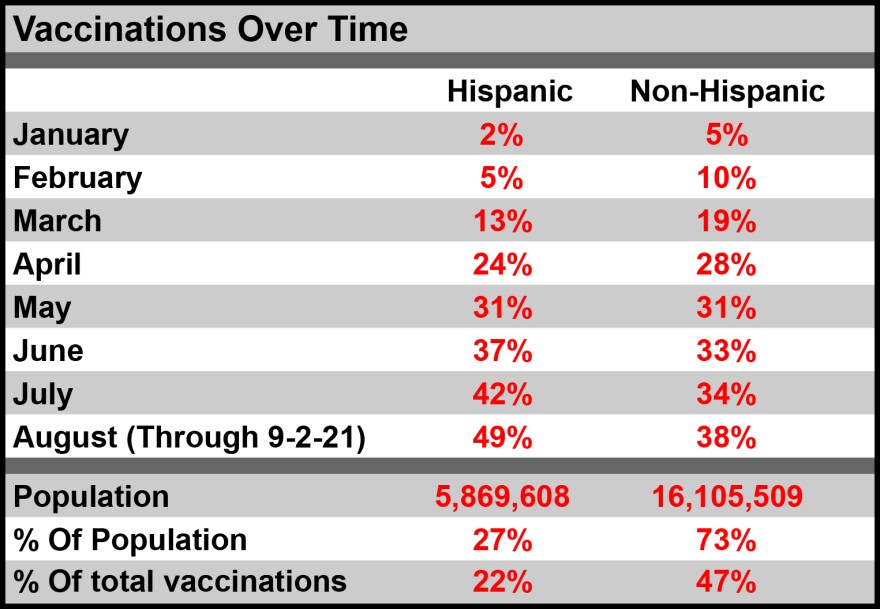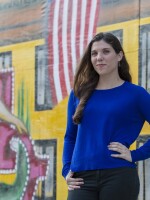Distrust is a key reason why many Hispanics in Florida were hesitant to get a COVID-19 vaccine, at least in the first several months of its rollout, according to community advocates. Vaccination rates among Hispanics were half that of non-Hispanics for the first several weeks of the rollout.
But gradually, over the last nine months, that trend changed. By mid-September, Hispanics were getting vaccinated at a much higher rate than non-Hispanics across the state.
What’s the secret to this success? Experts say it comes down to hard work by community leaders, health department officials and churches to address various barriers to health care access.
RELATED:
Early on, requiring ID and proof of residency to get a COVID-19 vaccine presented an obstacle for many of Florida’s 700,000 undocumented workers — — according to experts.
“There is so much distrust in the Hispanic community in relation to the establishment that it is very difficult to get people to come and actually get vaccinated,” said Graciela Greenberg, president of the Hispanic Democratic Caucus of Manatee County.
At an unveiling of a new testing and vaccine site at the Palmetto bus station in June, she approached Dr. Edwin Hernandez from the Manatee County Health Department to let him know about the problems she was facing.

Moments earlier, at a press conference, Hernandez had spoken to the media in Spanish and described the new site as “very special” because it aimed to address people’s hesitancy to taking the shots.
Tests and vaccines were free, he said, and the bus station location meant those without vehicles might find it easier to get there.
But Greenberg pointed out that both the weekday hours — 9 a.m. to 4 p.m. — and requiring ID that showed Florida residency, were significant barriers.
“The undocumented people are not going to come," she said. "They are not going to come.”
She’d seen it herself at a vaccine drive she organized at a Walmart in Palmetto just days earlier.
“We had 300 people who registered to come and get the vaccine. The purpose of registration was so that Walmart would know how many Pfizer vaccines to defrost,” Greenberg said.
“Of the 300 registrants, 15 people showed up.”
RELATED:
Greenberg said she believed that rumors of law enforcement involvement had quashed turnout.
“Somehow the word got around that we are the 'migra,' the immigration (authorities), and people just don’ t show up,” she said.
Hernandez, who is chief of clinical operations at the Manatee Department of Health, tried to clarify that IDs are not required.
“We are only requiring proof of address,” he said, noting that could be something like an electric bill.
He even offered to waive that, if needed.
“Even if people don't bring documentation of proof of address, we still offer the testing, we still offer the vaccine, because we want to offer them an honor system," Hernandez said. "So if you're here with a need, we'll provide what you need.”
It wasn’t just a need for ID that kept people away early on in the vaccine rollout. There was suspicion about the vaccines themselves, fueled by misinformation spread on social media.
In the Hispanic community in Florida, vaccine rates trailed behind non-Hispanics for months.

In February, when the vaccines became widely available, about 5 percent of the Hispanic population got the shot compared to 10 percent of the state’s non-Hispanic population.
Francis Luna, program manager at the Hispanic Services Council, said distrust was a big reason for the hesitancy early on.
“I think the things that we see in the Hispanic community are a lot of the things that we see in other communities, like the white population or African American or Asians or other minorities, is that they didn't really know what was happening," Luna said. "And things were changing so frequently, that they were questioning, like, who do we believe?”
Luna said her group began relying heavily on Spanish-speaking health advocates, who could promote the vaccine in their communities.
“We work with promotores de salud, or community health workers. And they're seen as a trusted source of information," she said. "Our promotores live in those communities and work with those community members. So they're an integral part for information sharing about vaccination efforts here locally.”
Spanish-language outreach was vital to helping people with limited English proficiency understand how the vaccines worked and how to get them, according to Ileana Cintron, chief strategist with Enterprising Latinas.
“The technical language that is associated with things like health, and how you feel and understand symptoms, it’s something that’s not easily translatable," she said.
Cintron's group has been active in expanding vaccine access in Wimauma, a rural community in Hillsborough County with a large Hispanic population.
"It’s so critical that we have access to information not only translated into Spanish but that is culturally sensitive, because the Hispanic community is enormously diverse, you know, so many different national origins and folks in different regions understand things in different ways.”
Local community groups played a key role throughout the pandemic in addressing the range of issues faced by Hispanics - whether among undocumented workers or those who’d lost jobs.
A last year showed six in 10 Hispanics lived in a household where someone lost wages or work.
Hispanics are more commonly working in service jobs than whites, those front line jobs that made exposure to coronavirus a near-daily risk.
And nationally, have been about twice as likely to get coronavirus and die compared to non-Hispanic white people -- and the three times more likely to be hospitalized.

Luz Corcuera, executive director of , said the pandemic exposed these inequities like never before.
“The social inequities have long been there. But there was more evidence of them with COVID because it forced people to reach out for help," Corcuera said.
"Before, people probably tried to just deal on their own, but they couldn't. They didn't have any jobs, no income, and the bills were piling up. And on top of it, they were terrified of getting sick.”
Community organizations ramped up their efforts, often in coordination with state and local health departments.
For a time, the Florida Division of Emergency Management to certain ZIP codes, informed by the CDC's , which looks at factors like income level and English proficiency to identify communities vulnerable to crises.
“So they'll go door to door, they'll ask them, 'Hello, are you interested in receiving the COVID-19 vaccine?'” said Stacey Gedeon, a nurse who led a team in Hillsborough, guided by color-coded maps.

“This area was marked as red because it's a heavy Latin community," she said, describing the maps. "They're usually laborers, day to day, definitely lower income on the socioeconomic ladder.”
Efforts like this helped vaccinate more people, like Oswaldo Simone, 66. Bilingual canvassers approached him one day as he left a Bravo Supermarket in the Town 'N Country neighborhood of Tampa. After a conversation with them in Spanish, he agreed to get the shot.
“It was the ideal moment and I think this is the way it should be done, promoting it like this," Simone said in Spanish. "Otherwise, I don’t know how I would have gotten the shot.”

Data gaps persist when it comes to Florida's vaccine delivery. Information on race and ethnicity is missing from 13% of the people vaccinated in the state.
By May 2021, Hispanics were no longer lagging behind non-Hispanics when it came to getting the vaccine. In June, they surpassed non-Hispanics for the first time.
As vaccination rates among other populations started to level off when coronavirus cases dropped, the number of Hispanics getting vaccinated kept steadily rising.
Between June and July, the vaccination rate among Hispanics rose 5 percent, compared to just 1 percent among non Hispanics.
Jan Booher follows the data closely, and consults with the Sarasota-based Multicultural Health Institute on pandemic trends. She said leadership from Catholic churches and community advocates helped make the difference.
“The Hispanics were running very low vaccination rates compared to non-Hispanics," Booher said. "And there was a lot of engagement. There was a tremendous amount of engagement from the Hispanic community.”
Community advocates spread the word that documents weren’t needed. Vaccine events were held on weekends, when people might be off work. There were interviews on Spanish language radio, as well as flyers and a social media push for the vaccines. Coalitions were formed with other Black and brown groups, with the shared goal of getting shots in arms.
And state data shows it worked. Vaccinations became more common among Hispanics in Florida, compared to non-Hispanic people.
As of mid-September, 49% of Hispanics are vaccinated statewide, almost 10 percentage points higher than non-Hispanics.
Cintron, with Enterprising Latinas, said the success really came down to establishing trust, one person at a time.
“It's the personal touch and the face-to-face that really allows for the conversations that are necessary for people to make the choice right now to get the vaccine,” Citron said.
Advocates say being there when people need help, and sending a consistent message, can break down barriers of distrust — lessons learned in the Hispanic community that may apply far beyond.
WUSF's Jose Jimenez contributed to this report. You can find our entire Unequal Shots series at WUSFNews.org.
Copyright 2021 WUSF Public Media - WUSF 89.7. To see more, visit . 9(MDAyNDY5MjM1MDEyODE2MzMyMTZmZDQwMg001))







